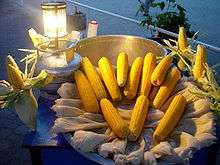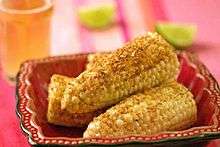Corn on the cob
Corn on the cob (known regionally as "pole corn", "corn stick", "sweet pole", "butter-pop" or "long maize") is a culinary term used for a cooked ear of freshly picked maize from a cultivar of sweet corn. Sweet corn is the most common variety of maize eaten directly off the cob.[1] The ear is picked while the endosperm is in the "milk stage" so that the kernels are still tender. Ears of corn are steamed or boiled, usually without their green husks, or roasted with them. The husk leaves are in any case removed before serving.
Corn on the cob is normally eaten while still warm. It is often seasoned with salt and buttered before serving.[1] Some diners use specialized skewers, thrust into the ends of the cob, to hold the ear while eating without touching the hot and sticky kernels.
Within a day of corn being picked it starts converting sugar into starch, which results in reduction in the level of natural sweetness. Corn should be cooked and served the same day it has been harvested, as it takes only a single day for corn to lose up to 25% of its sweetness.[2]
Preparation

The most common methods for cooking corn on the cob are frying, boiling, roasting, and grilling. Corn on the cob can be grilled directly in its husk, or it can be husked first and then wrapped in aluminum foil.[3] When oven roasting, cooking the corn in the husk directly on the rack is recommended.[4] When roasting or grilling corn on the cob, the cook can first peel the husk back to rub the corn with oil or melted butter, then re-secure the husk around the corn with a string.[5]
Common condiments and seasonings for corn on the cob include butter, salt, and black pepper.[5]
Etiquette
Lillian Eichler Watson, in a 1921 etiquette book, described corn on the cob as "without a doubt one of the most difficult foods to eat gracefully."[6] She added that "it is entirely permissible to use the fingers in eating corn, holding it lightly at each end; sometimes a napkin is used in holding it." Sometimes, however, a short sharp knife would be provided that each diner could use to cut or scrape the kernels from the cob for later eating. She described this as "by far the most satisfactory method" of eating corn on the cob.
Some etiquette books recommend salting and buttering the corn a section at a time just before eating that section,[7][8] which helps to minimize the mess on the diner's face and hands.[8] Butter dripping down the diner's chin and kernels getting stuck in-between teeth may be a source of embarrassment for the diner.[9]
Corn cob holders

Corn cob holders are eating utensils used to hold corn on the cob. They may have tines or a single spike, and have been used since ancient times, ranging from articles made of wood found in ethnographic museums[10] to precious tableware made of silver.[11]
Other utensils for eating corn on the cob include specialty knives from removing the kernels, brushes for removing the silk and knives for buttering.[12]
History
Corn was eaten by Native American tribes before European settlers arrived in the Americas. The Maya ate corn as a staple food crop and ate it off the cob, either roasting or boiling it. Aboriginal Canadians in southern parts of Canada also eat corn.[13]
Variations
Elote

Elote (Nahuatl: ēlōtl [ˈeːloːt͡ɬ]) is a popular street food in Mexico, although it is frequently served at home prepared in the same way (boiled or grilled in husk).[14] It is customarily consumed on a stick, or by grasping the husk of the cob that has been pulled down to form a "handle". Condiments such as salt, chile powder, butter, cotija, lemon juice or lime juice, and mayonnaise are usually added.
Another way of presenting elotes is by serving the cut kernels in a bowl. In the southern and central areas of Mexico, people call this esquites instead of elote. Any of the toppings above are added to the corn and it is then eaten with a spoon.
In the southern and central urban zones of Mexico, ready-to-eat boiled elotes are usually sold by street vendors or in stands, but in the rest of Mexico elotes are more frequently sold in stores or restaurants. The elotes are boiled in water or grilled over coals and condiments of the customer's choosing are added when sold.
See also
References
- 1 2 Nielsen, L. Michelle (2007). The Biography of Corn. Crabtree Publishing Company. p. 27.
- ↑ Stradley, Linda (2015-05-19). "Perfect Corn On The Cob, Whats Cooking America". What's Cooking America. Retrieved 2018-07-17.
- ↑ "How to Grill Corn on the Cob". What's Cooking in America. Retrieved 23 March 2012.
- ↑ Florence, Tyler. "Oven Roasted Corn on the Cob". Food Network. Retrieved 29 March 2012.
- 1 2 Herbest, David (2003). Simply Perfect Every Time: 130 Classic, Foolproof Recipes. New York: Avalon Publishing Groups Incorporated. p. 58.
- ↑ Watson, Lillian Eichler (1921). Book of Etiquette: Volume One. Garden City, New York: Nelson Doubleday Inc. p. 32.
- ↑ Sabath, Ann Marie (1993). Business Etiquette in Brief. Canada: Adams Media. p. 106.
- 1 2 Garner, Curtise (2009). The New Rules of Etiquette. Avon, Massachusetts: Adams Media. p. 76.
- ↑ Chaney, Lillian H. (2007). The Essential Guide to Business Etiquette. Westport, Connecticut: Praeger Publishers. p. 94.
- ↑ "Corncob holder made from wood made in Kenya". Horniman Museum and Gardens.
- ↑ "Sterling Sterling Corn Cob Holder". Ancient Point.
- ↑ Judksi, Maura (21 August 2017). "Corn on the cob is simple food. Why are there so many gadgets to help us eat it?". The Washington Post. Retrieved 23 August 2017.
- ↑ Nielsen 2007. p 11.
- ↑ "Mexican Corn on the Cob (Elote)". Allrecipes.com. Retrieved 6 July 2015.
